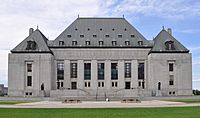R v Gladstone facts for kids
Quick facts for kids R v Gladstone |
|
|---|---|

|
|
| Hearing: November 27–29, 1995 Judgment: August 21, 1996 |
|
| Full case name | Donald Gladstone and William Gladstone v Her Majesty The Queen |
| Citations | [1996] 2 S.C.R. 723 |
| Ruling | Gladstone appeal allowed |
| Court membership | |
| Chief Justice: Antonio Lamer Puisne Justices: Gérard La Forest, Claire L'Heureux-Dubé, John Sopinka, Charles Gonthier, Peter Cory, Beverley McLachlin, Frank Iacobucci, John C. Major |
|
| Reasons given | |
| Majority | Lamer C.J., joined by Sopinka, Gonthier, Cory, Iacobucci and Major JJ. |
| Concurrence | L’Heureux‑Dubé J. |
| Concurrence | McLachlin J. |
| Dissent | La Forest J. |
| Laws applied | |
| R v Van der Peet, [1996] 2 S.C.R. 507 | |
R v Gladstone, [1996] 2 S.C.R. 723, is an important decision from the Supreme Court of Canada. This case helped explain the rights of Indigenous peoples in Canada that are not based on treaties. These rights are protected by Section 35 of the Constitution Act, 1982. The Court changed how a previous rule, called the Sparrow test, was used. This change gave the government more power to manage commercial fishing rights.
What Happened in the Case?
William and Donald Gladstone are members of the Heiltsuk First Nation, who live in British Columbia. They were involved in a legal case about selling herring eggs. The government's Fisheries Act had rules about selling fish.
The brothers argued that they had a right to sell herring eggs because of their Indigenous rights under Section 35 of the Constitution Act, 1982. During their trial, they showed proof that trading herring eggs was a very important part of the Heiltsuk way of life before Europeans arrived. The Court agreed that the Heiltsuk people had a long-standing right to gather herring eggs. It also agreed that this right included selling them.
The Court's Decision
Chief Justice Lamer wrote the main decision for the Supreme Court. He said that the Heiltsuk people did have an Indigenous right to sell herring eggs. This was based on another important legal rule called the Van der Peet test.
When thinking about how the government's rules might affect these rights, Chief Justice Lamer suggested a new approach. He said that when the government makes rules about commercial fishing, it should consider fairness for everyone in a region. This means thinking about how fishing resources are shared among all people, not just focusing on limited natural resources.
More About This Topic
- List of Supreme Court of Canada cases (Lamer Court)
- The Canadian Crown and First Nations, Inuit and Métis
- Canadian Aboriginal case law
- Numbered Treaties
- Indian Act
- Section Thirty-five of the Constitution Act, 1982
- Indian Health Transfer Policy (Canada)
- Heiltsuk
- Heiltsuk Nation

